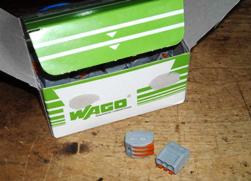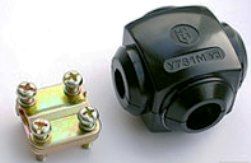Categories: Featured Articles » Electrician at home
Number of views: 339013
Comments on the article: 13
How to connect copper and aluminum wires
 It's no secret that it is not recommended to connect copper and aluminum wires. But many, even knowing this, still neglect it, hoping for the Russian "maybe it will pass."
It's no secret that it is not recommended to connect copper and aluminum wires. But many, even knowing this, still neglect it, hoping for the Russian "maybe it will pass."
In the end, such twisting of a pair of copper-aluminum will not live very long. And if the connection is on the street or in a room with high humidity, then the life span of such a pair is several times shorter.
But quite often, situations arise when we need to connect copper and aluminum wiring. Often this situation occurs when repairing electrical wiring in houses where aluminum wiring is laid.
Special terminal blocks and bolted connections will help us to get out of this situation, through which we will connect copper and aluminum wires. Using terminal and bolted connections, we do not allow direct contact of copper-aluminum pairs.
 Without really going into the design features of the terminal clamps, consider the most used of them.
Without really going into the design features of the terminal clamps, consider the most used of them.
One of the old and proven ways to connect wires is nut type terminal connections. They got their name because of the outward resemblance to nuts.
Connections of this type consist of three plates, between which, in fact, the wires are clamped. One of the advantages of this type of connection is that to connect the outgoing wire, there is no need to break the trunk. Simply unscrew the 2 bolts, insert a wire between the two plates, and tighten the bolts into place. The outgoing wire is inserted between the middle and the remaining plate. Everything, the connection is ready.
 The next most popular WAGO type connections. These connection terminals allow you to make wire connection made of aluminum and copper. It is enough just to strip the wires by 10-15 mm, insert into the terminal block hole, and that's it, the next connection is ready to work.
The next most popular WAGO type connections. These connection terminals allow you to make wire connection made of aluminum and copper. It is enough just to strip the wires by 10-15 mm, insert into the terminal block hole, and that's it, the next connection is ready to work.
The inside of the terminal block is filled with special grease, which does not allow the wires to oxidize. We recommend using this type of connection in lighting circuits. The use of these connections in power circuits is not recommended, since a large load can lead to heating of the springy contacts, and as a result to poor contact.
Another popular compound are terminal blocks. Externally, they are a bar with terminal blocks. It is enough to strip the end of the wire, insert into one hole and tighten the screw. The stripped end of the second wire is inserted into another hole. These terminal blocks also allow you to connect wires of different metals.
Bolted wire connections. This type of connection can also be used if you need to connect copper and aluminum wires. When mounting the connection, it is necessary to install a metal anodized washer between the copper and aluminum wires.
All installation work must be carried out by a specialist. All screw and bolt connections must be checked: for aluminum wires - once every half a year, for copper - once every two years.
Sergey Seromashenko
See also at bgv.electricianexp.com
:
